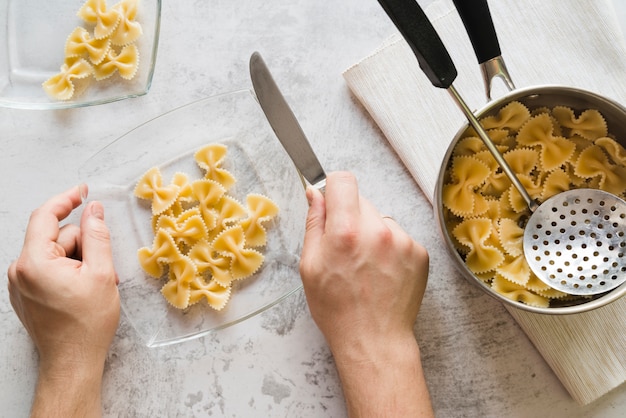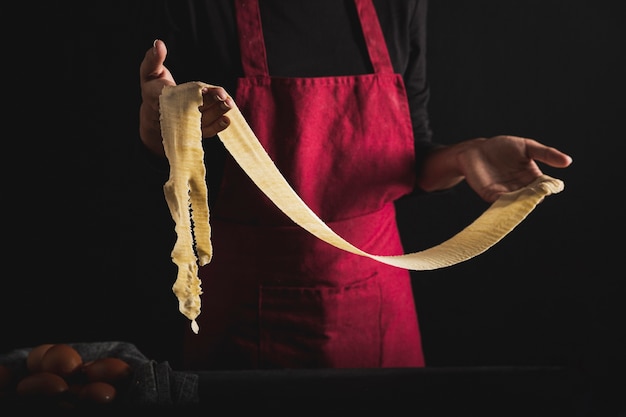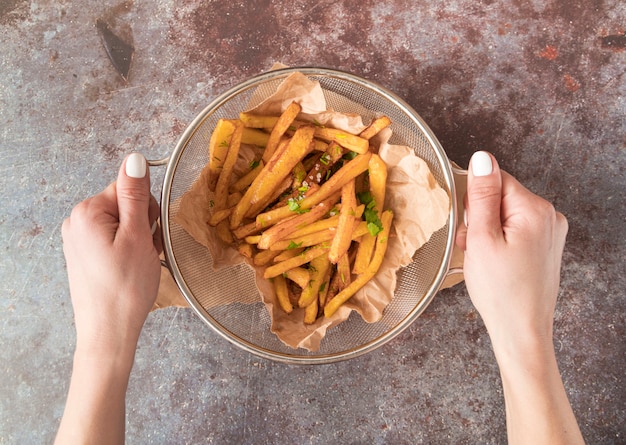Pasta - it's a culinary comfort, a versatile canvas for endless flavour combinations, and a staple in kitchens around the world. But getting the perfect bite, that elusive al dente texture, can sometimes feel like a culinary mystery. I've spent years perfecting my pasta skills, and I'm here to share my secrets, my triumphs, and even a few of those cringe-worthy pasta-related mishaps. Buckle up, folks, we're about to embark on a delicious journey through the world of pasta cooking times.
(Part 1) The Science of Pasta: Understanding the Process

Before we dive into specific pasta shapes and their cooking times, let’s talk about the science behind this humble yet essential food. It all boils down to understanding how pasta transforms from a firm, dry noodle to that delightful al dente perfection.
1. The Vital Role of Water
Water is the key. Think of it as the magical elixir that transforms pasta. The boiling water softens the starch molecules in the pasta, allowing them to swell and become tender. But here’s the crucial part – we don't want to overcook it! We're aiming for that perfect balance of tenderness with a bit of a bite, a texture that's both satisfying and elegant.
2. The Temperature Tango
Boiling water is essential because it provides the consistent heat needed to cook the pasta evenly. A simmering pot won't work as well, as the temperature fluctuations will result in inconsistent cooking. Think of it as a delicate dance between the water and the pasta. The water needs to be hot enough to coax the pasta to release its flavours and textures, but not so hot that it overwhelms the delicate process.
3. The Starch Symphony
Starch is the pasta's secret ingredient. It's what gives pasta its characteristic texture and allows it to absorb the deliciousness of sauces. As the pasta cooks, it releases starch into the water. This starch is what creates a silky sauce that clings to the pasta. It's truly a culinary symphony, where each element plays its part in creating a harmonious, flavourful experience.
(Part 2) Pasta Cooking Time: A Guide for Every Shape

Now, let's get down to the nitty-gritty of cooking times. Remember, these are just general guidelines. The actual cooking time can vary depending on the pasta's thickness, brand, and even your stovetop's heat output.
1. The Short and Sweet: Pasta Shapes Under 2 Inches
Short pasta shapes, like penne, rigatoni, and farfalle, are perfect for holding onto thick, hearty sauces. They're fun to eat, with their playful shapes and textures. They’re also relatively quick to cook, which is a bonus!
- Penne: 9-11 minutes. Penne pasta, with its iconic tubes, is a classic for a reason. It holds onto sauces beautifully and provides a satisfying bite.
- Rigatoni: 10-12 minutes. Rigatoni, with its larger tubes and ridges, is perfect for rich, meaty sauces. The ridges help to trap the sauce, creating a flavour explosion in each bite.
- Farfalle: 8-10 minutes. Farfalle, those delightful bowtie shapes, are a favourite amongst children and adults alike. They're versatile, working well with both creamy and tomato-based sauces.
- Orecchiette: 8-10 minutes. These little "ear" shapes are a traditional Italian pasta. They’re excellent for absorbing chunky sauces and are a delightful texture.
- Elbow Macaroni: 8-10 minutes. Elbow macaroni, with its iconic shape, is a classic for mac and cheese. It's also great for soups and salads.
2. The Long and Lean: Pasta Shapes Over 8 Inches
Long pasta, like spaghetti, fettuccine, and linguine, is a classic for a reason. They're elegant, versatile, and perfect for showcasing a wide range of sauces. They're also great for enjoying a casual weeknight meal or a fancy dinner party.
- Spaghetti: 8-10 minutes. Spaghetti, with its long, slender strands, is the ultimate comfort food. It's perfect for simple tomato sauce, creamy pesto, or even a spicy arrabiata.
- Fettuccine: 8-10 minutes. Fettuccine, with its wider ribbons, is a classic for alfredo sauce and other creamy concoctions. It's also delicious with mushroom sauces and pesto.
- Linguine: 9-11 minutes. Linguine, with its slightly flat, wide strands, is perfect for seafood sauces and delicate pesto. It's also great for a simple garlic and olive oil sauce.
- Bucatini: 9-11 minutes. Bucatini, with its long, hollow strands, is perfect for cheesy sauces and flavorful Roman-style dishes. The hollow centre allows the sauce to penetrate the pasta, creating a burst of flavour.
- Tagliatelle: 8-10 minutes. Tagliatelle, with its wider, flat ribbons, is a classic for Bolognese sauce. It's also delicious with meat sauces and mushrooms.
3. The Filled Delights: Pasta Shapes with a Surprise Inside
Filled pasta, like ravioli and tortellini, is a luxurious treat. It’s the perfect choice when you want to impress your dinner guests or indulge in a bit of culinary luxury. The key is to cook them gently, so the filling doesn’t burst out.
- Ravioli: 3-4 minutes. Ravioli, with its little pockets of deliciousness, can be filled with anything from cheese to spinach to meat.
- Tortellini: 4-5 minutes. Tortellini, with its small, crescent-shaped pockets, is often filled with meat or cheese. It's a favourite for broths and soups.
- Agnolotti: 4-5 minutes. Agnolotti, with its larger, square-shaped pockets, is often filled with meat or cheese. It's a traditional Italian pasta that's perfect for hearty sauces.
4. The Specialty Squad: Pasta Shapes with Unique Ingredients and Textures
Specialty pasta, like orzo, gnocchi, and lasagna noodles, adds a touch of creativity to any meal. They often feature unique shapes, colours, and flavours, making them exciting additions to your repertoire.
- Orzo: 8-10 minutes. Orzo, with its tiny rice-shaped pasta, is a great alternative to rice. It's perfect for soups, salads, and even as a side dish.
- Gnocchi: 2-3 minutes. Gnocchi, those pillowy potato dumplings, are a delight to eat. They’re best cooked gently in a large pot of boiling water. They can be tossed with a simple butter and sage sauce or a rich pesto sauce.
- Lasagna Noodles: 10-12 minutes (pre-cooked), 3-5 minutes (fresh). Lasagna noodles are the foundation for a classic Italian dish. They can be pre-cooked or fresh. Pre-cooked noodles require a shorter cooking time.
(Part 3) Beyond the Basics: The Art of pasta cooking techniques

Now, let’s take our pasta skills to the next level! These techniques are the secret weapons of experienced pasta cooks. They help elevate the pasta from good to fantastic.
1. The "Pasta water bath" for Delicate Pastas
For delicate pasta shapes, like gnocchi and filled pasta, the "pasta water bath" method is your best friend. It’s a gentle way to ensure even cooking and prevent the pasta from falling apart. Here's how it works:
- Gently simmer the pasta in a large pot of boiling water.
- After a few minutes, add a cup of cold water to the pot. This helps to shock the pasta, preventing overcooking.
2. The "pasta water splash" for Creamy Sauces
For creamy sauces, you want that perfect velvety smooth consistency. The "Pasta Water Splash" method is the magic trick for achieving this.
- When your pasta is almost done cooking, use a ladle to scoop out a cup of the pasta water.
- Add the pasta water to your sauce, a little at a time, while stirring constantly. This will help thicken the sauce and create a silky smooth consistency.
3. The "pasta water drain" for Lighter Sauces
For lighter sauces, you might want to drain the pasta before adding it to the sauce. This helps to prevent the sauce from becoming diluted. But to prevent sticking, toss the drained pasta with a tablespoon of olive oil. This keeps the strands separate and ensures a smooth sauce coating.
(Part 4) cooking pasta in a Sauce: A culinary adventure
Sometimes, the best way to cook pasta is directly in the sauce. This is especially true for dishes like cacio e pepe, where the pasta cooks in a simple cheese and pepper sauce. Here's how to do it like a pro:
1. The Art of Sauce Control
Ensure you have enough sauce to cover the pasta completely. The sauce should be simmering gently when you add the pasta. This ensures even cooking and prevents the pasta from sticking to the bottom of the pan.
2. The Stirring Symphony
Keep stirring the pasta and sauce constantly throughout the cooking process. This helps to prevent the pasta from sticking together and ensures it absorbs the flavours of the sauce evenly.
3. Mastering the Sauce Consistency
If you need to adjust the consistency of the sauce, add a little pasta water to thin it out or let it simmer for a few more minutes to thicken it. You can also add a little grated Parmesan cheese to enhance the flavour and help the sauce cling to the pasta.
(Part 5) pasta troubleshooting: Solving Your Culinary Dilemmas
We've all been there – a pasta disaster in the making. But don’t fret! Here are some tips to help you overcome those pasta-related challenges:
1. Pasta is Sticking Together
If your pasta is sticking together, it’s likely because the pot is overcrowded or the water isn’t boiling hot enough. Try adding more water or separating the pasta into batches. Make sure that the water is at a rolling boil before you add the pasta.
2. Pasta is Overcooked
Overcooked pasta will be mushy and will fall apart easily. If you've overcooked your pasta, you can salvage it by using it in other dishes, such as pasta salad or a frittata.
3. Pasta is Not Cooking Evenly
This could be because of an uneven heat distribution or a pot that’s too small. Ensure your pot is large enough to accommodate the pasta and that the water is boiling vigorously.
(Part 6) Pasta cooking tips for Every Situation
Here are some extra tips to help you navigate different pasta-related scenarios:
1. Cooking Pasta for a Crowd
When cooking for a large group, cook the pasta in batches to ensure even cooking and prevent it from becoming overcooked. If you're using a large pot, you may be able to cook all the pasta at once, but remember to stir regularly to prevent sticking.
2. Cooking Pasta for a Single Serving
For a single serving, there’s no need to fill a large pot with water. Cook it in a smaller pot with just enough water to cover the pasta. This saves time and water.
3. Cooking Pasta for a Leftover Sauce
If you have leftover sauce, cook the pasta in it. This allows the pasta to absorb the flavours of the sauce. Just add a little pasta water to thin out the sauce if necessary.
(Part 7) Expanding Your Pasta Horizons: Exploring Different Types of Pasta
Beyond the classic shapes, there’s a world of pasta varieties waiting to be discovered! Each type offers a unique flavour and texture, adding variety and excitement to your pasta repertoire.
1. Whole Wheat Pasta: A Nutritious Twist
Whole wheat pasta has a nuttier flavour and is a good source of fibre. It can be a bit more challenging to cook than traditional pasta, so always check the cooking time on the package.
2. Gluten-Free Pasta: A Delicious Alternative
Gluten-free pasta, made from ingredients like rice, quinoa, or lentils, is a great option for those with gluten sensitivities. It has a slightly different texture than traditional pasta, but it can still be delicious. Keep a close eye on it, as it can cook quickly.
3. fresh pasta: A Culinary Delights
Fresh pasta, made with eggs and flour, has a delicate texture and flavour that's hard to beat. It cooks quickly, usually in 1-2 minutes, and it’s best served immediately after cooking. It's a whole different experience, offering a burst of fresh flavour and a tender bite that's hard to resist.
(Part 8) FAQs: Your Pasta Cooking Questions Answered
Let's address those burning pasta questions that pop up in the kitchen.
1. What happens if I overcook pasta?
Overcooked pasta will be mushy and will fall apart easily. It will also lose its flavour and texture. If you’ve overcooked pasta, there’s not much you can do to fix it. However, you can use it in other dishes, such as pasta salad or a frittata.
2. What happens if I undercook pasta?
Undercooked pasta will be hard and chewy. It won’t absorb the sauce as well, and it will be difficult to eat. You can always cook it for a few more minutes if needed.
3. Can I add pasta water to my sauce?
Yes! Pasta water is your secret weapon for creating creamy sauces. It contains starch, which helps to thicken the sauce and create a smoother consistency.
4. How do I know when my pasta is done?
The best way to know when your pasta is done is to taste it. It should be al dente, which means firm but not hard, with a slight bite. You can also check the packaging for cooking time guidelines.
5. What’s the best way to store leftover pasta?
Store leftover pasta in an airtight container in the refrigerator. It’s best to eat it within 3-4 days. You can also freeze leftover pasta for up to 3 months.
Now you're ready to conquer the pasta world! Remember, practice makes perfect, so don’t be afraid to experiment and find what works best for you. Happy pasta-making, my friends!
Everyone is watching

Corn on the Cob: The Ultimate Guide to Perfectly Cooked Ears
Healthy MealsAh, corn on the cob. Just the name evokes images of sunny days, barbecues, and that sweet, juicy flavour that ...

Perfect Pork Roast Oven Cooking Time: A Guide to Delicious Results
Healthy MealsThere's something truly satisfying about a perfectly roasted pork. The aroma alone is enough to make your mout...

Ham Cooking Time: How Long to Bake, Smoke, or Boil a Delicious Ham
Healthy MealsAh, ham. It's a classic, isn't it? A real crowd-pleaser, especially around holidays. And when done right, it'...

Scallops: The Ultimate Guide to Perfect Cooking
Healthy MealsAh, scallops. Those delicate, sweet, and utterly delicious morsels of the sea. They hold a special place in my...

Spaghetti Squash: The Ultimate Guide to Cooking and Serving
Healthy MealsRemember that time you saw spaghetti squash at the supermarket, looking all bumpy and strange, and thought, "W...
